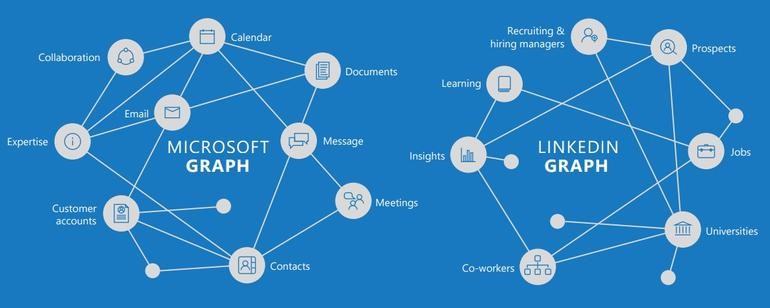Accelerating Your Business with the Microsoft-LinkedIn Integration
In June 2016, Microsoft announced the acquisition of the world's largest business networking platform, LinkedIn, for a record breaking price tag of $26.2 billion. Since then, both the LinkedIn platform and Microsoft Business Productivity Suite have shown signs of joint evolution. However, in September of this year at Microsoft's annual user conference Inspire, CEO Satya Nadella announced the first major step in merging the data graphs from the two companies with an integration of:
- The world's most popular suite of business productivity tools, Office 365
- A powerful unified platform for customer relationship management (CRM) and enterprise resource planning (ERM), Dynamics 365
- The largest social selling tool, Sales Navigator.
The data sharing and distribution now possible between these powerful technologies gives today's businesses who take advantage of it, a unique opportunity to accelerate growth and productivity like never before. In this article we'll explain the significance of this announcement and how you can leverage all three of these solutions to gain unprecedented insight and efficiency within your organization.
Office 365 and Dynamics 365
Office 365 is a business productivity and collaboration tool. It organizes users who work from within an enterprise and enables them to easily connect to circles both inside and outside of the organization and be more productive. Popular Office 365 applications such as Excel, PowerPoint and Word are now common place for most organizations and as cloud-first, mobile-first modernization and AI assisted functionality grows, these resources will only continue to amplify communication and collaboration abilities across the value and supply chains. Each Office 365 user has a loosely structured data profile that is associated with their skills, background, personality, behavioral preferences and connections to other users. Entities served through O365 include: users, projects, teams, sessions, calls, messages, conversation threads, queues, projects, documents, knowledge base, and portals.
Dynamics 365 for Customer Engagement (CRM) is a business transaction and customer relationship management system. It is of course also about increasing productivity however, the focus for this tool is on disciplined and ordered business cycles that involve users, customers, partners, vendors in revenue acquisition and customer-facing delivery functions. Unlike the loosely structured data in O365, D365 data is highly structured in a relational database management system that emulates a business model to support business processes that generate revenue. Business entities served through D365 include: users, prospect businesses, customers, partners, distributors, leads, competitors, products, opportunities, quotes, sales orders, campaigns, lists, knowledge base, cases, work orders, portals, and delivery projects. Dynamics 365 for financial/operations extends process management to entities such as: invoicing, P&L, HR, cash management, purchasing, inventory, fulfillment and all operational aspects of the business.
Acceleration with the LinkedIn Graph
LinkedIn operates on the same user profile concept as O365 and D365, except it is for individuals at large, in the realm of personal networking. LinkedIn correlates to both Office 365 and Dynamics 365 in that it has the ability to identify a user or participant in a process, and build an association with their LinkedIn profile so that the context around their resume can be leveraged in every work-stream including: their work history, past projects, their personality, work status, work goals, and most importantly, their circle of friends and co-workers who may be valuable to you...the Dynamics or Office 365 user. LinkedIn not only works at the individual level, but also brings in rich business information as well.
Imagine opening up a Dynamics CRM customer record, and seeing not only their structured data from your company's interactions with them, but their LinkedIn profile and the relationships they have with people you know or businesses you are pursuing or already working with. Â With the Dynamics 365 and LinkedIn integration you can see at a glance your contact's level of influence and reach within the industries or accounts you are targeting so you can leverage those relationships. This data sharing is helpful not only in opening doors but also spotting risks. Using history of interactions across your organization combined with LinkedIn activities and relationships, your Dynamics CRM can now alert sales reps when clients or prospective deals are at risk. This allows your sales team to focus their efforts on your most a-risk and highest-value accounts and generate more accurate projections for success. Instantly tapping into these key personal interrelationships that help drive your business will be a significant differentiator and competitive advantage.
A properly implemented and maximized marriage of LinkedIn and Microsoft enables you to:
- Get more done through the people you know
- Get more Leads
- Obtain better, prequalified intelligence on competitors and resources
The modern, smart experiences and services you can gather with this connected data across your enterprise can also help you find the right mix of skills and connections to avoid project friction and round out any collaborative effort. At a minimum the potential access to more data will help you and your staff make better, faster, more confident decisions and achieve optimal outcomes.
In Closing
The sales impact of the Microsoft-LinkedIn integration is only one of the many examples of how integrated business insights can accelerate your business. Another big win already tangible from this integration is in human resource. From more targeted recruiting processes to faster internal candidate reviews, the benefits of this union has only just begun. Organizational Microsoft data combined with social data from LinkedIn using baked in AI algorithms will make the road to digital transformation less and less rocky for businesses of all sizes as this integration grows. We are excited to see what data-driven, intelligent enhancements to the Microsoft ecosystem are coming in 2018!

